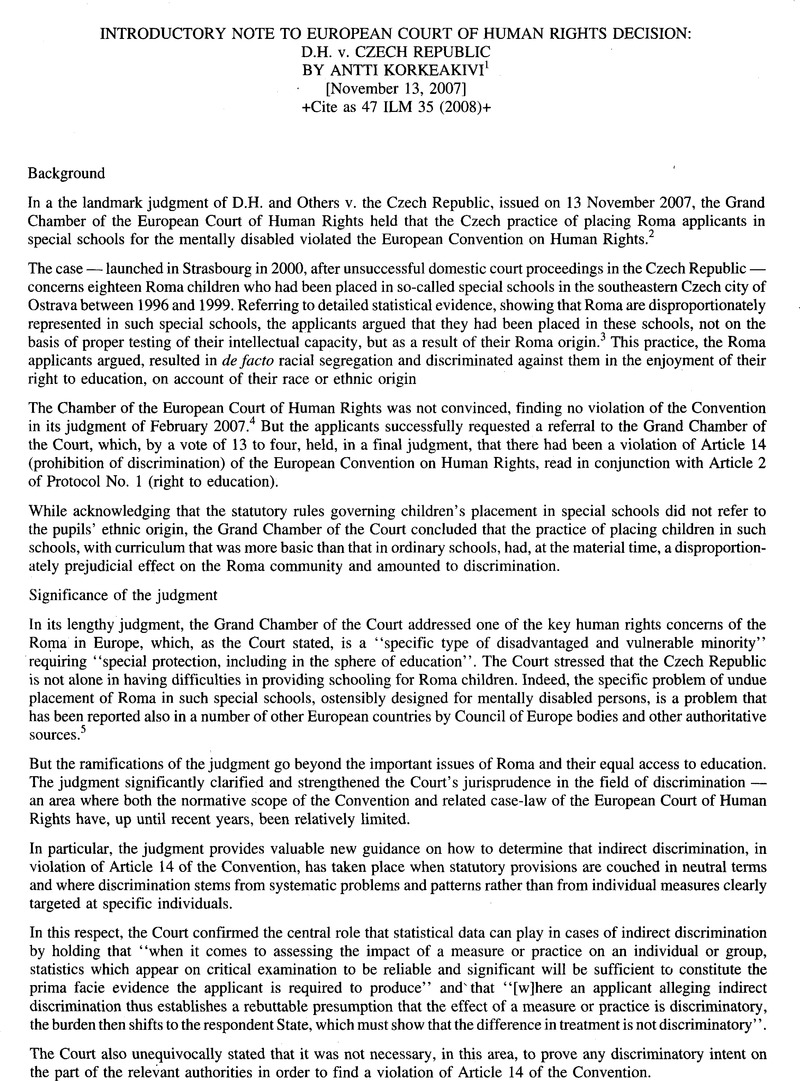No CrossRef data available.
Published online by Cambridge University Press: 27 February 2017

This text was reproduced and reformatted from the text appearing at the European Court of Human Rights website (visited January 25, 2008) <http://cmiskp.echr.coe.int/tkpl97/view.asp?item=2&portal=hbkm&action=html&highlight=D.H.%20%7C%20Czech%20%7C%20Republic&sessionid=4953204&skin=hudoc-en>
page 37 note 2 Grand Chamber of the European Court of Human Rights, D.H. and others v. the Czech Republic, Application no. 57325/ 00, Judgment Nov. 13, 2007.
page 37 note 3 The statistics collected by the European Roma Rights Center, the leading NGO behind the case, showed that, in 1999, 56% of all pupils placed in special schools in Ostrava were Roma while Roma represented only 2.26% of the total number of pupils attending primary school in the city. The applicants were also able to refer to Government's own data contained in its first state report submitted under the Framework Convention for the Protection of National Minorities, according to which Roma pupils made up between 80% and 90% of the total number of pupils in some special schools in 1999.
page 37 note 4 Chamber of the European Court of Human Rights, D.H. and Others v. the Czech Republic, Application no. 57325/00, Judgment Feb. 7, 2006, <http://www.echr.coe.int/echr> For a critique of the Chamber judgment, see Morag Goodwin, D.H. and Others v. Czech Republic: A Major Set-Back for the Development of Non-Discrimination Norms in Europe 1 German L. J. 421 (2006),<http://www.germanlawjournal.com>.
page 37 note 5 See, e.g., the Advisory Committee on the Framework Convention for the Protection of National Minorities, Second Opinion on Slovakia, adopted on 26 May 2005, <http://www.coe.int/minorities>
page 37 note 6 Address by Louise Arbour, United Nations High Commis-sioner for Human Rights at the Opening of the Judicial Year 2008 of the European Court of Human Rights, Strasbourg ( Jan. 25, 2008), <http://www.echr.coe.int/NR>. 7Protocol No. 12 to the Convention for the Protection of Human Rights and Fundamental Freedoms, Europ.T. S. No. 177.
page 37 note 7 Protocol No. 12 to the Convention for the Protection of Human Rights and Fundamental Freedoms, Europ.T. S. No. 177.
page 91 note 1 Evans, P. (2006), ‘Educating students with special needs: A comparison of inclusion practices in OECD countries', Education Canada 44 (1): 32–35.Google Scholar
page 91 note 2 Frazer, A. (Miklušákova, M.), The Gypsies (Cikdni), Prague 2002, p. 275.Google Scholar
page 91 note 3 J.-P. Liégeois, Roma in Europe, to be published by Council of Europe Publishing.
page 91 note 4 Nevertheless, in a census taken of the population of the Czech Republic on 3 March 1991, only 32,903 people claimed to be members of the Roma (Statistical Yearbook of the Czech Republic 1993, Prague 1993, p. 142).
page 91 note 5 Op. cit. (text subject to editorial revision).
page 91 note 6 Official Journal of the European Communities C 153 of 21/ 06/1989, pp. 3 and 4.
page 91 note 7 Statistical Yearbook of the Czech Republic 1993, Prague 1993, pp. 88 and 302
page 91 note 8 Statistical Yearbook of the Czech Republic 1993, Prague 1993, p. 307.
page 91 note 9 In the public debate currently underway in France, it has been noted that “40% of pupils entering the first form do not have a basic education. At the end of the fourth form, 150,000 young people leave the system without mastering any subject (Editorial in the ‘Figaro', 4 September 2007). The same news paper related in an article on 7 September 2007 that “ac cording to the Education Board, 40% of primary-school pu pils-300,000 children in all-leave each year with severe failings or in great difficulty”.
page 91 note 10 A. Schopenhauer, The World as Will and Representation (Volume II), this tranlsation by EFJ Payne, Dover, New York 1966, p. 145.
page 91 note 11 E.g. Willis v. the United Kingdom, no. 36042/97, § 48, ECHR 2002-IV.
page 91 note 12 Gaygusuzv. Austria, judgment of 16 September 1996,Reports of Judgments and Decisions 1996-IV, par. 42.